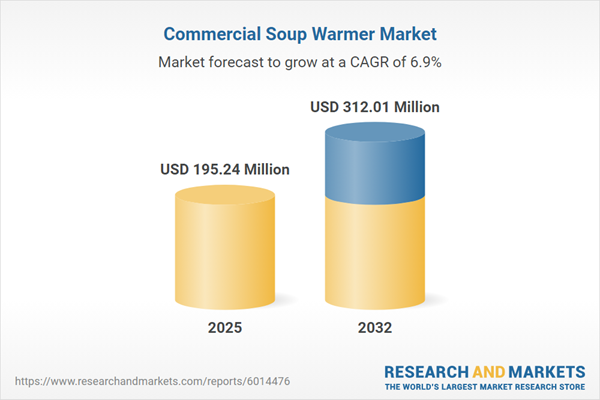Speak directly to the analyst to clarify any post sales queries you may have.
The commercial soup warmer market is advancing rapidly, driven by evolving operator needs, technological upgrades, and sustained demand for efficient foodservice solutions. Senior stakeholders face new opportunities and challenges in optimizing kitchen operations, navigating regulatory pressures, and leveraging emerging innovation.
Market Snapshot: Commercial Soup Warmer Market Size and Trajectory
The commercial soup warmer market grew from USD 183.21 million in 2024 to USD 195.24 million in 2025. Projected to advance at a CAGR of 6.88%, the sector is anticipated to reach USD 312.01 million by 2032. This robust expansion reflects rising adoption across professional kitchens, new product launches, and a sustained focus on food safety, operational efficiency, and shifting end-user preferences.
Scope & Segmentation of the Commercial Soup Warmer Market
This market research report analyzes a dynamic landscape shaped by heating innovation, diverse capacity requirements, regulatory impacts, and evolving customer usage across global regions. Segment coverage includes:
- Heating Technology: Electric systems, gas-powered units, and induction-based warmers offer varying advantages for energy efficiency and rapid heat delivery.
- Capacity: Models designed for below 5 liters, 5 to 10 liters, and above 10 liters address space constraints and output demands from small bistros to high-volume operations.
- Mobility: Countertop placements and floor-standing configurations cater to front-of-house flexibility or large-scale back-of-house deployment.
- End User: Commercial settings including cafes, bistros, full-service restaurants, hotels, resorts, quick service restaurant chains, and supermarkets.
- Distribution Channel: Both offline (equipment dealers) and online sales channels impact access, support, and engagement.
- Regions: Americas (with North America and Latin America), Europe, Middle East & Africa (covering regional nuances), and Asia-Pacific—including leading destinations such as the United States, Germany, China, and India.
Key Takeaways: Strategic Trends and Market Drivers
- Compliance, safety, and hygiene protocols have prompted manufacturers to integrate advanced features such as overheat protection, spill prevention, and touchless operation, supporting regulatory and end-user demands.
- Sustainability remains a core focus. Manufacturers employ high-efficiency heating elements, sustainable insulation, and recyclable components—it is an increasingly important differentiator in procurement.
- Smart technology and connectivity innovations are enhancing maintenance, energy monitoring, and operations, giving managers tools for data-driven optimization and predictive upkeep.
- Customization and modularity address both display and kitchen integration, enabling operators to align warming equipment with aesthetics, workflow, and space requirements.
- Competitive differentiation is being shaped by value-added services, leasing models, bundled maintenance, and training offerings, supporting operational continuity and lifetime value.
- Quick adoption in growth regions is influenced by regulatory frameworks, infrastructure maturity, and consumer taste diversity. Regional specialists continue to tailor product offerings to meet these distinct requirements.
Tariff Impact: Navigating Cost Structures and Supply Chain Shifts
Forthcoming United States tariffs on critical components are leading manufacturers to diversify sourcing, build inventory buffers, and explore local fabrication to minimize margin pressure. Small and mid-sized enterprises may face acute challenges adapting to these cost shifts. Scenario planning and supplier negotiations have become central to protecting price competitiveness and managing risk within the supply chain.
Methodology & Data Sources
This study combines structured interviews with leading equipment producers, distribution partners, and end users, supplemented by secondary research from technical publications and trade associations. Custom analytical frameworks and scorecard approaches have been validated through peer review and data triangulation for robust, actionable findings.
Why This Report Matters to your Commercial Soup Warmer Business
- Provides actionable insights for solution design, procurement, and partnership strategies aligned with leading foodservice trends.
- Identifies risks and opportunities in supply chain planning, operational efficiency, and customization to meet competitive and regulatory demands.
- Enables benchmarking of product offerings, services, and maintenance models, supporting value creation and improved client relationships.
Conclusion
The commercial soup warmer market is defined by innovation, regulatory adaptation, and changing customer needs. Organizations that invest in modularity, connectivity, and agile sourcing will be best positioned to capitalize on future growth and industry transformation.
Additional Product Information:
- Purchase of this report includes 1 year online access with quarterly updates.
- This report can be updated on request. Please contact our Customer Experience team using the Ask a Question widget on our website.
Table of Contents
3. Executive Summary
4. Market Overview
7. Cumulative Impact of Artificial Intelligence 2025
Companies Mentioned
The companies profiled in this Commercial Soup Warmer market report include:- Admiral Craft Equipment Corp.
- APW Wyott Manufacturing
- Atosa Catering Equipment Co., Ltd.
- Avantco Equipment, LLC
- Cambro Manufacturing Company
- CookTek Inc.
- Duke Manufacturing Co.
- Globe Equipment Company
- Hatco Corporation
- Nemco Food Equipment Company, Inc.
- Paragon Food Equipment
- Server Products Inc
- Star Manufacturing International, Inc.
- Sunnex Corporation
- The Vollrath Company, L.L.C.
- Winco Manufacturing
Table Information
| Report Attribute | Details |
|---|---|
| No. of Pages | 195 |
| Published | November 2025 |
| Forecast Period | 2025 - 2032 |
| Estimated Market Value ( USD | $ 195.24 Million |
| Forecasted Market Value ( USD | $ 312.01 Million |
| Compound Annual Growth Rate | 6.8% |
| Regions Covered | Global |
| No. of Companies Mentioned | 17 |









